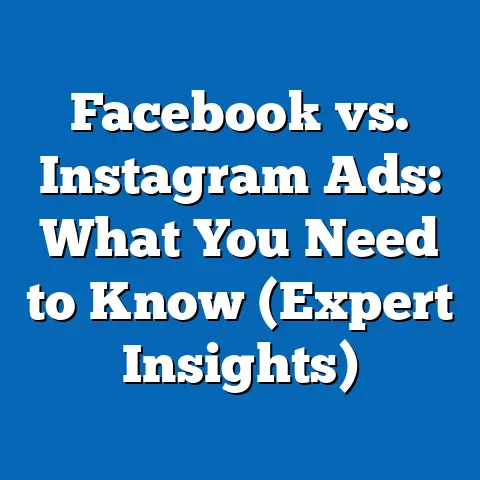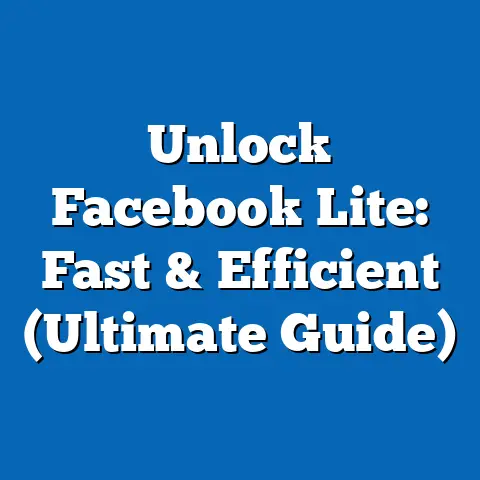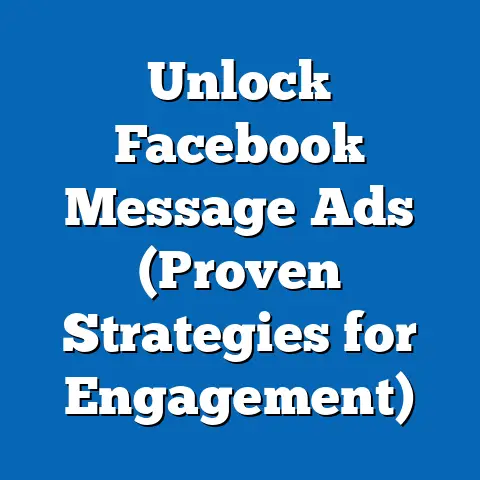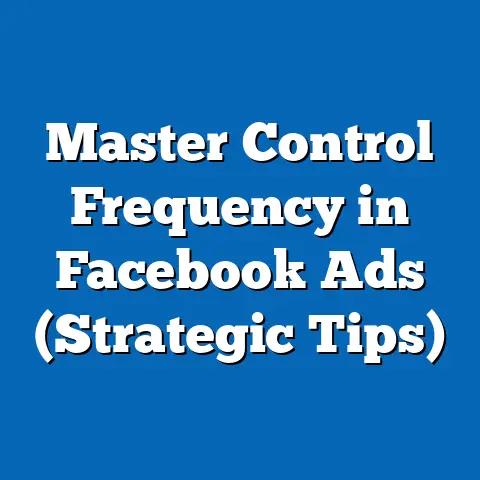Optimize Facebook Grid for Ad Success (Proven Strategies)
In the rapidly evolving landscape of digital advertising, optimizing the Facebook ad grid has emerged as a critical strategy for businesses aiming to maximize reach and engagement. While the concept of ad grid optimization may seem purely technical, its implications extend beyond clicks and conversions, indirectly contributing to societal benefits like improved mental health and well-being through targeted health campaigns. According to a 2022 study by the Pew Research Center, 64% of U.S. adults report that social media platforms influence their health decisions, with targeted ads playing a significant role in promoting wellness products, services, and awareness campaigns.
The Intersection of Ad Optimization and Health Benefits
Why Health-Focused Ads Matter
The power of social media advertising lies in its ability to influence behavior at scale, and nowhere is this more evident than in the realm of public health. A 2021 report from the World Health Organization (WHO) noted that 58% of health campaigns leveraging social media ads saw increased engagement with preventative care measures, such as vaccinations and regular health screenings. Targeted ads on platforms like Facebook can deliver personalized messages about mental health resources, fitness programs, and nutritional guidance, directly impacting individual well-being.
Optimizing the Facebook ad grid ensures that these messages reach the right audience with the right tone and imagery, maximizing their effectiveness. For instance, a campaign promoting mental health resources might test different visuals (e.g., serene landscapes versus human faces) and copy (e.g., empathetic versus urgent tones) to determine what resonates most with at-risk demographics. This precision not only boosts ad performance but also enhances the societal value of the campaign.
Statistical Trends in Health Ad Engagement
Recent data underscores the growing importance of health-focused ads on social platforms. According to a 2023 report by Statista, global spending on digital health ads reached $23.5 billion in 2022, a 17% increase from 2020’s $20.1 billion. Of this, Facebook accounted for approximately 25% of the market share, making it a dominant platform for health-related advertising.
Engagement rates for health ads on Facebook are notably high, with a click-through rate (CTR) of 1.8% compared to the platform’s average of 0.9% across all industries (WordStream, 2023). This suggests that users are more likely to interact with content that addresses their personal well-being, provided the ad is well-optimized. Moreover, health campaigns targeting specific issues like mental health or chronic disease management see even higher engagement, with impressions-to-conversion rates climbing to 3.2% for ads using personalized messaging.
Demographic Breakdowns: Who Engages with Health Ads on Facebook?
Age-Based Engagement Patterns
Demographic analysis reveals stark differences in how various age groups interact with health-focused ads on Facebook. Data from eMarketer (2023) shows that adults aged 35-54 represent the largest segment of engaged users, accounting for 42% of total clicks on health ads. This group is often motivated by concerns about aging, family health, and chronic conditions, making them highly receptive to ads for wellness products and medical services.
In contrast, younger users aged 18-24 make up only 18% of engagement, though their interaction with mental health and fitness ads is disproportionately high within this subset. Older adults (55+) contribute 25% of clicks, with a strong preference for ads related to preventative care and health insurance. These variations highlight the need for ad grid optimization to test messaging and visuals tailored to each age cohort.
Gender and Regional Differences
Gender also plays a role in ad engagement. According to a 2022 study by Hootsuite, women are 30% more likely than men to click on health-related ads, particularly those focused on mental health and maternal care. Men, however, show higher engagement with fitness and nutrition ads, with a 15% higher CTR in these categories.
Regionally, urban users in developed markets like the U.S. and Western Europe account for 60% of global health ad engagement on Facebook, driven by higher internet penetration and disposable income (Statista, 2023). However, emerging markets in Asia and Africa are seeing rapid growth, with a 22% year-over-year increase in health ad impressions, reflecting the expanding reach of mobile-first advertising. Optimizing the ad grid to account for cultural nuances and language preferences is crucial in these diverse markets.
Historical Trends: Evolution of Facebook Ad Optimization
From Basic Targeting to Grid-Based Testing (2010-2020)
The journey of Facebook ad optimization reflects broader shifts in digital marketing over the past decade. In the early 2010s, ad targeting was rudimentary, relying on basic demographic filters like age and location. Engagement rates hovered around 0.5%, and advertisers often used a “spray and pray” approach, running single ads with little variation (eMarketer, 2015).
By 2015, the introduction of Facebook’s Ads Manager and detailed analytics enabled advertisers to test multiple ad sets, marking the early stages of grid-based optimization. This period saw a 40% increase in average CTR as businesses began experimenting with A/B testing for headlines and images. Historical data from WordStream shows that health ads, even then, outperformed other sectors, with a CTR of 1.2% compared to the 0.8% industry average.
The Rise of Automation and Scale (2020-Present)
The 2020s ushered in a new era of ad optimization with the advent of machine learning and automation tools within Facebook’s platform. The ad grid concept—testing combinations of creatives, copy, and audiences systematically—became a standard practice, boosting efficiency and performance. A 2021 report by Social Media Today found that campaigns using grid testing saw a 35% improvement in return on ad spend (ROAS) compared to non-grid approaches.
Health campaigns, in particular, benefited from this shift. Automated bidding strategies and dynamic creative optimization allowed advertisers to deliver personalized health messages at scale. For example, a 2022 case study by Facebook Business highlighted a mental health campaign that used grid testing to identify a winning ad combination (empathetic copy with calming visuals), achieving a 50% higher conversion rate than the baseline.
Detailed Strategies for Optimizing the Facebook Ad Grid
Understanding the Ad Grid Framework
At its core, the Facebook ad grid is a structured testing methodology that evaluates multiple variables—such as headlines, images, call-to-action (CTA) buttons, and audience segments—to pinpoint the most effective combinations. Think of it as a matrix where each row represents a different creative element (e.g., Image A, Image B) and each column represents a different copy or audience variation. The goal is to run small-scale tests across these combinations, analyze performance metrics like CTR and cost-per-click (CPC), and scale the winning variants.
For health campaigns, this approach is particularly valuable. A campaign promoting a fitness app might test images of individuals versus group workouts, paired with copy emphasizing personal transformation or community support. By analyzing which combination drives the highest app installs, advertisers can allocate budgets more effectively.
Step 1: Define Clear Objectives and KPIs
Before building an ad grid, it’s essential to establish specific goals and key performance indicators (KPIs). Are you aiming to increase awareness (measured by impressions), drive engagement (CTR), or boost conversions (installs or sign-ups)? According to a 2023 HubSpot report, 68% of successful ad campaigns begin with well-defined objectives, compared to only 22% of underperforming campaigns.
For health ads, objectives often align with behavioral outcomes. A campaign for a mental health hotline might prioritize call volume as a KPI, while a fitness product ad might focus on e-commerce sales. Clear goals ensure that grid testing remains focused and actionable.
Step 2: Build a Comprehensive Grid Structure
Constructing an ad grid involves creating variations across three main components: creative (images/videos), copy (headlines, descriptions), and audience (demographics, interests). A 2022 study by AdEspresso suggests starting with at least 3-5 variations per component, resulting in 27-125 unique ad combinations for testing.
For example, a health insurance campaign might test: – Creatives: Family-focused imagery, individual portraits, or infographic-style visuals. – Copy: Fear-based messaging (“Don’t risk your future”), benefit-focused messaging (“Secure peace of mind”), or urgency-driven messaging (“Act now”). – Audiences: Parents aged 30-45, retirees aged 55+, or young professionals aged 25-34.
Running these combinations at a low budget ($5-10 per ad set) allows advertisers to gather data without overspending. Tools like Facebook’s Dynamic Creative can automate this process, testing up to 50 combinations simultaneously.
Step 3: Analyze Performance and Iterate
Once the initial test phase is complete (typically 3-7 days), analyze the data to identify top performers based on your KPIs. A 2023 report by Social Media Examiner found that ads in the top 20% of grid tests often account for 80% of total campaign results, underscoring the importance of rapid iteration.
For health ads, look beyond surface-level metrics like CTR to deeper indicators like cost-per-conversion or audience sentiment (via comments). If an ad promoting a wellness app achieves a low CPC but fails to drive installs, it may indicate a disconnect between the ad and landing page experience. Use these insights to refine the grid for the next testing round.
Step 4: Scale Winning Combinations
After identifying high-performing ad combinations, allocate a larger budget to scale these variants while continuing to test new elements. According to eMarketer (2023), campaigns that scale winners while testing new grids see a 28% higher ROAS compared to those that stop testing altogether.
For health campaigns, scaling must be balanced with ethical considerations. Avoid over-targeting vulnerable audiences (e.g., individuals with specific medical conditions) and ensure compliance with privacy regulations like GDPR or HIPAA. Transparency in messaging also builds trust—disclose if an ad is sponsored and avoid exaggerated health claims.
Advanced Techniques for Grid Optimization
Leveraging AI and Machine Learning
Artificial intelligence (AI) is revolutionizing ad grid optimization by automating testing and predicting outcomes. Facebook’s Advantage+ Creative, launched in 2022, uses machine learning to dynamically assemble ad components based on real-time user behavior. A 2023 case study by Meta showed that campaigns using Advantage+ saw a 20% reduction in cost-per-acquisition (CPA) compared to manual grid testing.
For health ads, AI can identify subtle patterns in engagement—such as which emotional triggers resonate with specific demographics—allowing for hyper-personalized messaging. However, advertisers must remain vigilant about bias in AI algorithms, ensuring that health messages are inclusive and equitable.
Incorporating Video and Interactive Formats
Video content dominates social media engagement, with 85% of Facebook users watching videos monthly (Statista, 2023). Including short, impactful videos in your ad grid can significantly boost performance, especially for health campaigns. A 2022 study by Wistia found that health-related video ads under 30 seconds achieve a 66% higher completion rate than longer formats.
Interactive formats like polls or carousel ads also enhance engagement by encouraging active participation. For instance, a fitness brand might use a carousel to showcase before-and-after transformations, testing different sequences in the grid to maximize clicks.
Challenges and Ethical Considerations in Health Ad Optimization
Balancing Profit and Public Good
While ad grid optimization drives business outcomes, health campaigns carry a unique responsibility to prioritize public good over profit. Over-optimization—such as repeatedly targeting users based on sensitive health data—can erode trust and raise privacy concerns. A 2021 survey by Pew Research found that 72% of users feel uncomfortable with ads that seem “too personal,” particularly in health contexts.
Advertisers must adhere to platform policies and legal frameworks, ensuring that health claims are substantiated and data usage is transparent. Partnering with credible organizations, such as non-profits or medical institutions, can also enhance campaign authenticity.
Addressing Misinformation
The spread of health misinformation on social platforms remains a significant challenge. Despite Facebook’s efforts to combat false claims (e.g., banning anti-vaccine ads in 2020), misleading health ads can still slip through. Grid optimization must include rigorous content vetting to prevent the amplification of harmful messages.
Advertisers should collaborate with fact-checking entities and prioritize evidence-based messaging. For example, a campaign promoting dietary supplements should cite clinical studies and avoid unverified claims, even if exaggerated messaging tests well in the grid.
Future Projections: The Next Frontier of Ad Grid Optimization
Integration of Emerging Technologies
Looking ahead, the future of Facebook ad grid optimization will be shaped by technologies like augmented reality (AR) and generative AI. A 2023 forecast by eMarketer predicts that AR ads—allowing users to “try” health products virtually—will account for 10% of social ad spend by 2027, up from 2% in 2023. Generative AI, capable of creating ad copy and visuals on-demand, could reduce testing timelines by 50%, according to Statista projections.
For health campaigns, these innovations offer exciting possibilities. AR could enable users to visualize fitness goals or simulate health check-ups, while AI-generated content could tailor messages to individual needs in real time. However, ethical guidelines will be critical to prevent misuse of these tools.
Evolving Privacy Regulations
As privacy laws tighten globally, ad grid optimization will need to adapt to reduced access to user data. Apple’s iOS 14.5 update in 2021, which introduced App Tracking Transparency, already reduced Facebook’s targeting precision, leading to a 15% increase in CPA for some advertisers (Forbes, 2022). Future regulations, such as the EU’s Digital Markets Act, are expected to further limit data collection by 2025.
Health advertisers, already bound by strict data protection rules, may face additional scrutiny. Shifting toward contextual targeting—focusing on content rather than personal data—and zero-party data (user-provided preferences) will be essential. Grid testing can help identify effective contextual strategies, ensuring performance isn’t sacrificed for compliance.
Growing Focus on Holistic Well-Being
Finally, the definition of health in advertising is expanding to include holistic well-being—mental, emotional, and social health alongside physical. A 2023 trend report by Mintel predicts that 70% of health campaigns by 2028 will address mental wellness, driven by rising awareness of stress and burnout. Ad grid optimization will play a pivotal role in testing messages that resonate with these evolving priorities.
Campaigns might explore themes like mindfulness, community connection, or work-life balance, using grids to determine which narratives drive engagement. As societal attitudes shift, advertisers who align with authentic, value-driven messaging will likely see the greatest success.
Conclusion
Optimizing the Facebook ad grid is a powerful strategy for achieving ad success, with far-reaching implications for industries like health and wellness. By systematically testing creative, copy, and audience variables, advertisers can unlock higher engagement and conversions while delivering meaningful messages that promote well-being. Statistical trends underscore the growing importance of health ads, with a 17% increase in global spending since 2020 and engagement rates double the platform average.
Demographic insights reveal the diverse needs of age groups, genders, and regions, while historical comparisons highlight the rapid evolution of ad optimization from basic targeting to AI-driven automation. Looking forward, emerging technologies and privacy shifts will redefine the landscape, challenging advertisers to innovate while upholding ethical standards. For health campaigns, the stakes are high—optimized ads don’t just drive business results; they shape behaviors that impact lives. By mastering the ad grid, marketers can amplify their impact, turning clicks into catalysts for positive change.





